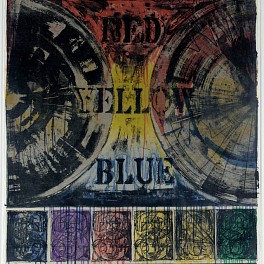BIOGRAPHY

B. 1930 -
In the late 1950s, Jasper Johns emerged as force in the American art scene. He is best known for his painting "Flag" (1954-55), which he painted after having a dream of the American Flag. He is often described as a pop artist, because his subject matter includes images and objects from popular culture.
Born in 1930 in Augusta, Georgia, he grew up in South Carolina. He was drafted in the army and stationed in Japan. Between 1947 and 1948 Johns studied at the University of South Carolina, and then moved to New York City and studied briefly at Parsons School of Design. Living in New York, Johns met a lot of notables on the contemporary art scene, such as Robert Rauschenberg, Merce Cunningham and John Cage.
The modern art community was searching for new ideas to succeed the pure emotionality of the Abstract Expressionists. Johns' paintings of targets, maps, invited both the wrath and praise of critics. The meaning of painting was found in the painting process itself. The simplicity and familiarity of the subject matter triggered viewers' interest in both Johns' motivation and his process.
In 1958, gallery owner Leo Castelli visited Rauschenberg's studio and saw Johns' work for the first time. Castelli was so impressed with the young man's ability that he offered him a show on the spot. During that first exhibition, the Museum of Modern Art purchased three pieces, establishing Johns' place in the art world.
Johns' love of the artistic process led him to printmaking. He would often make counterpart prints to his paintings. The ease of repeat endeavors allowed by printmaking was what attracted Johns at first. And later, his innovations in screen printing, lithography, and etching have revolutionized the field.
Over the past fifty years Johns has created a body of rich and complex work. He was given a comprehensive retrospective at the Whitney Museum of American Art, New York, in 1977, shown in 1978 at the Museum Ludwig, Cologne, Musée National d'Art Moderne, Paris, and Seibu Museum of Art, Tokyo. Today, he remains at the forefront of American art, with work represented in nearly every major museum collection.
